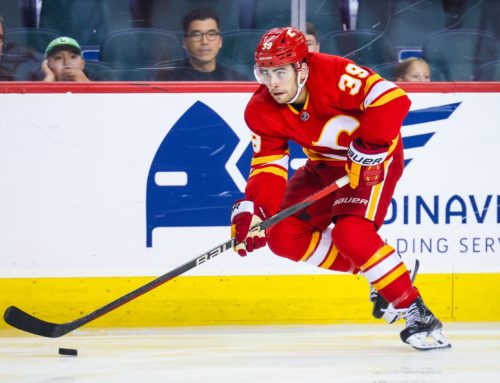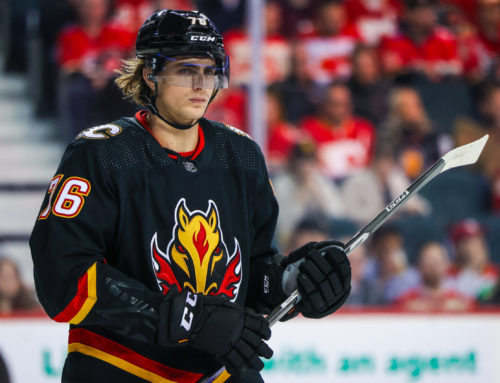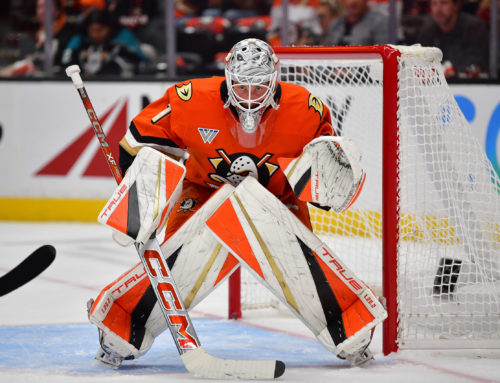
During bubble keeper week, you’ll have a hard time finding a 50-point player that has more upside heading into this season than Kevin Labanc. Let’s dive in.
Labanc was drafted by the San Jose Sharks 171st overall in the sixth round of the 2014 NHL entry draft. He went on to explode offensively in the OHL, putting up 127 points in 65 games in his third season with the Barrie Colts (2015-16).
He’s listed at 5-11 and was probably considered undersized in 2014, but the NHL has evolved quite nicely for smaller skilled forwards since that time.
Labanc is heading into his fourth NHL season and will turn 24 in December. If you believe in the magical fourth season combined with the 24-year-old peak production year, then it’s a pretty nice place to start fantasy wise.
Labanc is on a single year $1-million contract. Contending cap-leaguers should rejoice, as this has the potential to be one of the best value contracts in the NHL. It’s a bit of a head scratcher, as it seems Labanc and his agent left literally millions of dollars on the table. He’s betting on himself and generally we like that.
The Sharks lost Joe Pavelski and Gustav Nyquist in the offseason which leaves a gaping hole in San Jose’s top six that needs filling. The face of the franchise, “Jumbo” Joe Thornton, remains unsigned, but they’ve got the two best offensive defensemen in the league locked up for the next six seasons.
Losing Pavelski and keeping Erik Karlsson was the right play for the Sharks and there shouldn’t have been any doubt that GM Doug Wilson would do whatever it took to sign Karlsson. Having one of Brent Burns or Karlsson on the ice for more than 80 percent of every game will increase the fantasy value of every forward in the top six.
Labanc is one of several baby Sharks (Doo Doo Doo Doo Doo Doo) that are emerging offensively.
As Bob Dylan would say: The Times They Are a-Changin’ in San Jose.
Labanc spent over 40 percent of his time playing with Thornton and Marcus Sorensen on the third line last year and averaged only 14:01 in ice time.
With third line deployment and only 48 percent of his team’s power-play time, he was still able to produce offensively with 17 goals and 39 assists.
Labanc’s points-per-game average has increased every year: 0.36, 0.52, to 0.68. We absolutely love upward trends. Combine additional deployment opportunity with upward trends and we have the potential for fantasy gold. That’s gold, Jerry! Gold!
Let’s take a look at Labanc’s quarterly production breakdown from last year:
|
2018/19 Quarter |
GP
|
G |
A |
PTS |
SOG |
PPP |
PPTOI |
TOI |
|
1 |
21 |
3 |
9 |
12 |
45 |
3 |
2:18 |
14:15 |
|
2 |
22 |
1 |
11 |
12 |
27 |
8 |
1:13 |
13:04 |
|
3 |
20 |
7 |
10 |
17 |
26 |
5 |
2:04 |
12:18 |
|
4 |
19 |
6
📢 advertisement:
|
9 |
15 |
32 |
4 |
2:18 |
15:15 |
Table courtesy of Dobber’s Frozen Tools (https://frozenpool.dobbersports.com/players/kevin-labanc)
Take a glance at the third quarter. Labanc had 17 points in 20 games with less than 13 minutes of ice time. Small sample size? Sure. Unsustainable? Almost certainly. But the scoring ability has always been there and his second half was quite impressive overall. He produced at a rate of 67 points over an 82-game span.
Similar to his year-over-year trend, he’s moving upwards from the first half to the second half with comparable deployment. All while averaging around 14 minutes a night and some inconsistency on the top power-play unit. Notice he had fewer power-play points in the second half of the season despite receiving more time.
Here’s where Labanc stacked up in points-per-60-minutes last season (Only players with a minimum of 20 games played were included):
|
Rank |
Player |
GP |
G |
A |
TOI |
PTS/60 |
|
45 |
77 |
33 |
40 |
19:53 |
2.9 |
|
|
46 |
82 |
36 |
34 |
17:50 |
2.9 |
|
|
47 |
76 |
33 |
35 |
18:24 |
2.9 |
|
|
46 |
82 |
17 |
39 |
14:01 |
2.9 |
Pretty good company and well within the top 50 players.
One thing we’d like to see is more shots from Labanc, as he has a career high of 156 and last year he only took 130 over 82 games.
We want his shots at over two per game and a two to four minute increase in ice time could get him there. Why would he get such a big boost in ice time? Because when you combine the departure of key forwards and consider the remaining roster as well as Labanc’s play last season, it’s difficult to find a reason to keep him out of the top six.
If he were to play a full season in the top six, he should see at least 16 minutes a night which gives us a two-minute increase. If he somehow found himself attached to Logan Couture’s wing, he could easily see 17-18 minutes per night.
His shooting percentage last year was the highest we’ve seen at 13.1 and his career average sits at 10.1. Depending on how much his ice time increases, 200 shots is within reach.
With better linemates, more ice time, and potentially more power-play time, we should feel reasonably good about a 13 percent shooting percentage. We could see in the range of 20-25 goals from Labanc.
If he’s able to produce assists at the same rate he did last season, but we increase his average ice time by only two minutes, we arrive at 44 assists. Those projections would put him at 64-69 points, which seem quite reasonable.
Labanc could be receiving fringe keeper consideration on your fantasy team, depending on the number of players kept and the categories of your league.
We should put his floor at 55 points and project somewhere around 65 points, with upside of 70 if everything were to bounce right for him. If you’re in a cap league, he will provide extreme value, even at his floor, and becomes a must keep.
All things considered, we have a very solid breakout candidate with good potential for a huge deployment boost.





 EDM
EDM FLA
FLA CHI
CHI ANA
ANA CGY
CGY OTT
OTT
